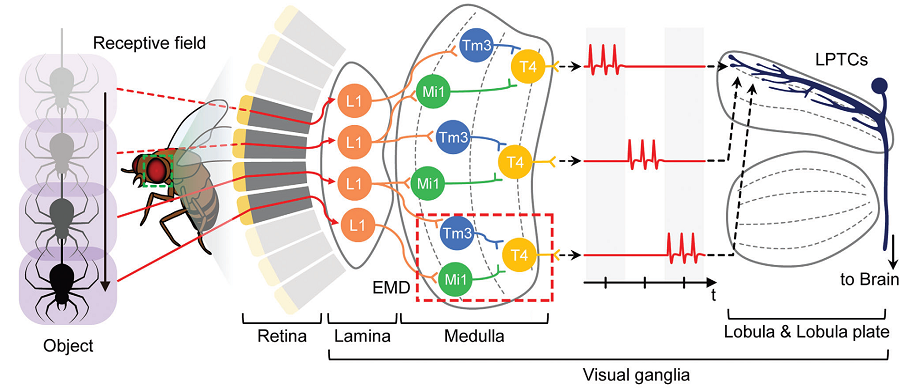Reviewed by Lexie CornerMar 1 2024
The advent of a cutting-edge semiconductor called the “intelligent sensor” has opened up new possibilities for a range of innovative technologies.
 Working principle of a biological elementary motion detection system. Image Credit: Korea Advanced Institute of Science and Technology.
Working principle of a biological elementary motion detection system. Image Credit: Korea Advanced Institute of Science and Technology.
This remarkable technology, which mimics the optic nerve of insects, operates at incredibly high speeds and consumes minimal power. Its potential applications span diverse fields, such as transportation, safety, and security systems, making significant contributions to industry and society.
The intelligent motion detector, developed successfully by the KAIST research team under the leadership of Professor Kyung Min Kim from the Department of Materials Science and Engineering (DMSE), combines different memristor devices to replicate the visual intelligence found in the optic nerve of insects.
Due to the latest developments in AI technology, vision systems are enhancing their capabilities by incorporating AI in tasks like image recognition, object detection, and motion analysis. Current vision systems usually use intricate algorithms to identify objects and their actions from image signals. This approach results in substantial data traffic and increased power usage, posing challenges for implementation in mobile or IoT devices.
Insects can efficiently analyze visual data using a specialized optic nerve circuit known as the elementary motion detector. This circuit enables them to identify objects and perceive their movement with great precision. Replicating this pathway using traditional silicon integrated circuit (CMOS) technology necessitates intricate circuitry, which has hindered its practical application in real-world devices.
Professor Kyung Min Kim's research team has successfully created a cutting-edge motion-detecting sensor with exceptional efficiency and remarkable speed. This sensor boasts a straightforward design, comprising solely of two distinct memristors and a resistor, all of which were developed by the team. These two memristors serve different functions, facilitating signal delay and enabling signal integration and ignition. By utilizing these components, the team was able to replicate the intricate workings of an insect’s optic nerve, allowing for precise analysis of object movement.
The research team utilized the recently created motion detector to create a neuromorphic computing system, showcasing its practical applications. This system successfully predicted the trajectory of a vehicle and consumed 92.9 % less energy than current technology while also achieving higher accuracy in motion prediction.
Insects make use of their very simple visual intelligence systems to detect the motion of objects at a surprisingly high speed. This research is significant in that we could mimic the functions of a nerve using a memristor device. Edge AI devices, such as AI-topped mobile phones, are becoming increasingly important. This research can contribute to the integration of efficient vision systems for motion recognition, so we expect it to be applied to various fields, such as autonomous vehicles, vehicle transportation systems, robotics, and machine vision.
Kyung Min Kim, Professor and Study Lead Author, Department of Materials Science and Engineering (DMSE), KAIST
This research, spearheaded by co-first authors Hanchan Song and Min Gu Lee, both Ph.D. candidates at KAIST DMSE, was published in the online issue of Advanced Materials on January 29th, 2024.
The Mid-Sized Research Project by the National Research Foundation of Korea, the Next-Generation Intelligent Semiconductor Technology Development Project, the PIM Artificial Intelligence Semiconductor Core Technology Development Project, the National Nano Fab Center, and the Leap Research Project by KAIST provided support for this research.